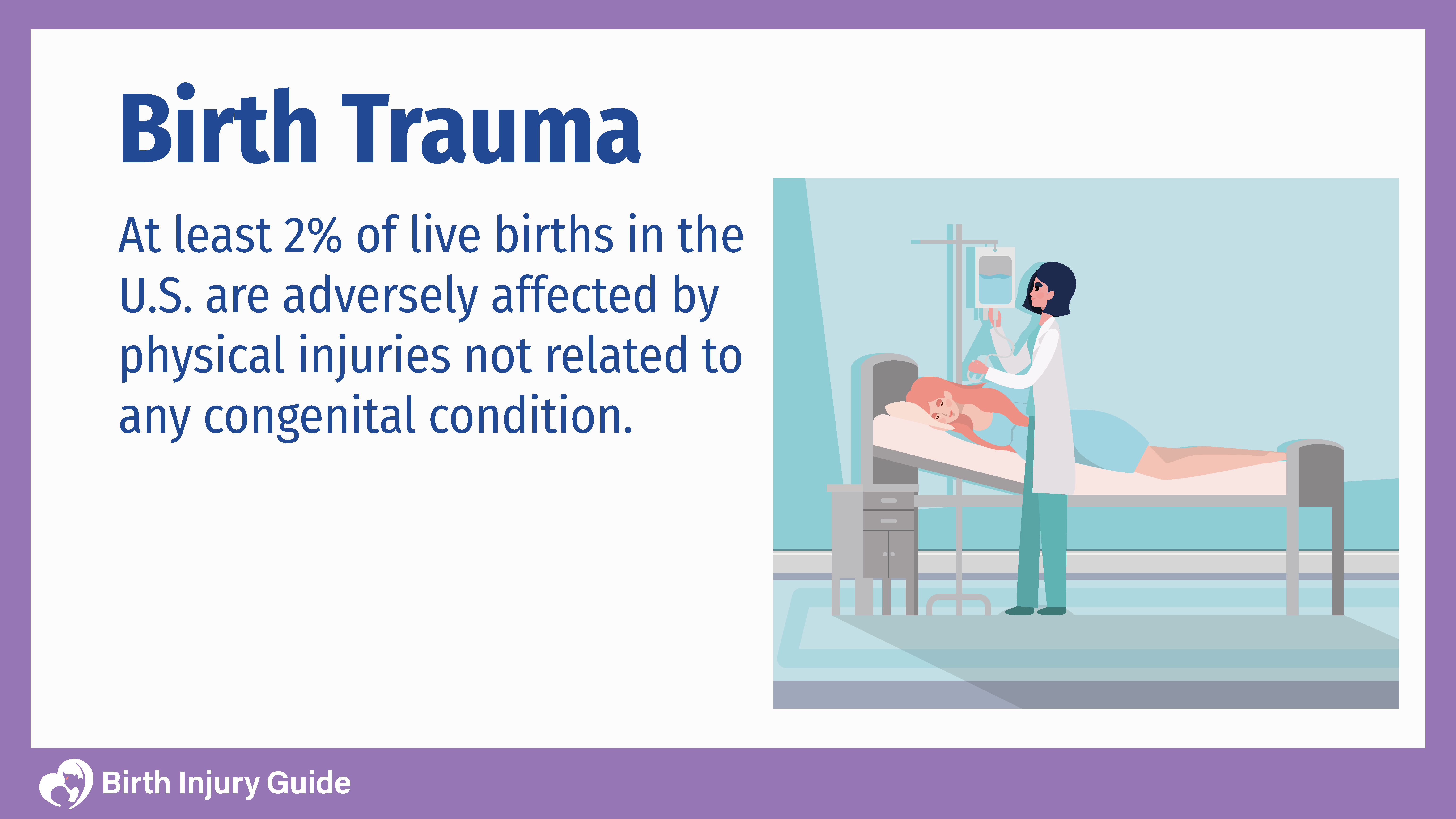
Birth Trauma
Although most babies in the United States are delivered with few or no physical injuries, there is always a chance that something will go wrong during the birth process. On average, 29 out of every 1,000 babies in the U.S. suffer some kind of birth trauma, often as a result of poor use of instruments or improper handling of a newborn by doctors or other medical staff.

What is Birth Trauma?
Birth trauma is a general term used to describe any cuts, fractures, or other injuries sustained by a newborn baby during labor or delivery. Birth trauma is more common in developing nations in Africa, Asia, and Latin America. However, at least two percent of live births in the U.S. are adversely affected by physical injuries not related to any congenital condition.
Birth trauma occurs more frequently among larger-than-average babies, particularly in cases where the baby’s size may be too large in relation to the mother’s pelvis. Deliveries of larger, heavier babies often require doctors to use their hands, forceps, or vacuums to ease their passage through the birth canal. In these situations, neonatal injuries can occur if a doctor uses too much physical force while handling the baby or is not careful with birthing instruments.
What Causes Birth Trauma?
Per Stanford’s Lucile Packard Children’s Hospital the most common conditions that cause birth trauma include:
- Babies that weigh over 8 pounds, 13 ounces (4,000 grams)
- Babies born before the 37th week of pregnancy
- The mother’s pelvis may have the wrong shape or size for a safe delivery
- Difficult labor or delivery (dystocia)
- Prolonged labor
- Abnormal fetal position at birth (baby is in a head-up, buttocks-first, or breech, position)
Common Birth-Related Traumas
Generally, the most common neonatal injuries affect a baby’s head, neck, and shoulders, although they can cause damage to any other part of the body. These areas of the body are more likely to be injured because most babies are born in a head-first position. The most common traumatic injuries include:
Caput Succedaneum
Caput succedaneum is a condition marked by scalp swelling, typically during or shortly after birth. It is usually caused by pressure from the mother’s uterus or vaginal wall during delivery. Bruising of the scalp is more likely to happen during a long and difficult labor, especially in situations when the amniotic sac has broken and the baby’s head must change its shape while passing through the birth canal.
Caput succedaneum can also be caused by the use of vacuum extraction devices during a protracted delivery. It is not considered dangerous and resolves on its own.
Cephalohematoma
Cephalohematoma is an accumulation of blood below the baby’s skull and the periosteum, the protective membrane that covers an infant’s skull. Often, newborn cephalohematoma is first noticed when bulges appear on the baby’s head, usually several hours after delivery. The bulges feel soft and may grow larger during the baby’s first hours postpartum.
Most cephalohematomas do not require medical attention and disappear within a few weeks or months as the body reabsorbs the blood. However, some cephalohematomas may cause jaundice if they are too large and too many red blood cells break down.
Bruising and Broken Bones
Bruising and petechiae may occur on a baby’s face, head, and/or other body parts due to the physical stresses of the passage through the birth canal or contact with bones and tissue in the mother’s pelvis. The use of forceps during delivery may also leave forceps marks on a newborn’s head or face, especially when doctors use too much force. In addition, vacuum extraction may cause lacerations or bruising on a baby’s scalp.
Broken Bones
Broken bones can also occur with improper use of birth-assisting tools or when an infant is tugged too forcefully. In extremely rare instances, a physician or someone on the medical staff may drop a newborn causing broken bones.
Subconjunctival Hemorrhage
Subconjunctival hemorrhage is bleeding that occurs when small blood vessels in the baby’s eyes break. Parents may notice their baby is red around the eyes. It may be present in one or both of the infant’s eyes and appears as a bright red band surrounding the iris. Subconjunctival hemorrhages do not cause permanent damage to the eyes. The red area vanishes within a matter of days as the body reabsorbs the blood.
Bell’s Palsy
Bell’s palsy occurs when a baby’s facial nerve is damaged during labor or birth. In most cases, nerve damage is caused by pressure on the infant’s face during the passage through the birth canal. However, facial paralysis can be also caused by the use of forceps during delivery.
Nerve damage is most noticeable when babies cry. The facial muscles on the side where the nerve was injured can’t move, and the eye on that side remains open.
Bell’s palsy eventually improves without treatment if the nerve is only bruised. If the baby’s facial nerve is torn, surgery may be needed to restore function in the affected area.
Brachial Plexus Injury
A brachial plexus injury is the result of an injury to a baby’s brachial plexus. The brachial plexus is a network of nerves that connects the spinal cord to the arms and hands. Brachial plexus injury is a common occurrence in difficult births, especially if a baby’s shoulder gets stuck in the birth canal and a doctor tugs hard on one arm to help extract the newborn or exerts excessive downward traction on the neck after the head delivers.
The most common sign of a brachial plexus injury is when a baby can’t flex or rotate the affected arm. The severity of the injury depends on how badly damaged the nerves are. If the nerves are only bruised or stretched, the injury generally heals over a period of weeks or months and arm movement is restored with the aid of physical therapy. More serious injuries, in which the nerves are torn, often result in permanent nerve damage.
Oxygen Deprivation
Oxygen deprivation at birth or shortly after birth can cause serious health problems. This type of birth of trauma can occur for a variety of reasons, such as umbilical cord prolapse, placental abruption (premature separation of the placenta) or a prolonged labor.
Oxygen deprivation can also occur if a baby doesn’t start breathing independently after birth. Delays in breathing that last for three minutes or more are a high-risk factor for brain damage. Oxygen deprivation destroys brain cells within a matter of minutes and can cause seizures, coma, or death if a baby is not resuscitated and placed on life support in time.
Oxygen deprivation can lead to permanent disabilities like cerebral palsy, and is also a major cause of hearing impairment, partial or total blindness, learning disabilities and other complications.
Prognosis for Birth Trauma
When birth trauma is recognized and treated in a timely manner, the prognosis is generally favorable. Injuries like abrasions, lacerations, caput succedaneum and cephalohematoma all have a favorable short- and long-term prognosis. Of course, your child’s prognosis will depend on a variety of factors, including his or her overall health, additional conditions or injuries, and how well he or she responds to treatment.
Sources:
- http://www.stanfordchildrens.org/en/topic/default?id=birth-injury-90-P02340
- http://www.merckmanuals.com/home/childrens_health_issues/problems_in_newborns/birth_injury.html
- https://www.ninds.nih.gov/Disorders/All-Disorders/Cerebral-Hypoxia-Information-Page
- http://www.medicalnewstoday.com/articles/152712.php
- https://emedicine.medscape.com/article/980112-overview#a1



